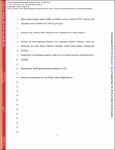Whole genome-based public health surveillance of less common STEC serovars and untypable strains identifies four novel O genotypes
Lang, Christina
Hiller, Miriam
Konrad, Regina
Fruth, Angelika
Flieger, Antje
Shiga toxin-producing E. coli (STEC) and the subgroup of enterohemorrhagic E. coli cause intestinal infections with symptoms ranging from watery diarrhea to hemolytic uremic syndrome (HUS). A key tool for epidemiological differentiation of STEC is serotyping. The serotype in combination with the main virulence determinants gives an important insight into the virulence potential of a strain. However, a larger fraction of STEC found in human disease, including strains causing HUS, belongs to less frequently detected STEC serovars or their O/H antigens are unknown or even untypable. Recent implementation of whole genome sequence (WGS) analysis in principal allows the deduction of serovar and virulence gene information. Therefore we here compared classical serovar and PCR-based virulence marker detection with WGS-based methods for 232 STEC strains focusing on less frequently detected STEC serovars and non-typable strains. We found that WGS-based extraction showed a very high degree of overlap with the more classical methods. Specifically, concordance was 97% for O antigens (OAGs) and 99% for H antigens (HAGs) of typable strains and > 99% concerning stx1/2 or eaeA for all strains. 98% of non-typable OAGs and 100% of non-typable HAGs were defined by WGS analysis. In addition, the novel methods enabled a more complete analysis of strains causing severe clinical symptoms and the description of four novel STEC OAG loci. In conclusion, WGS is a promising tool for gaining serovar and virulence gene information especially from a public health perspective.
Dateien zu dieser Publikation

